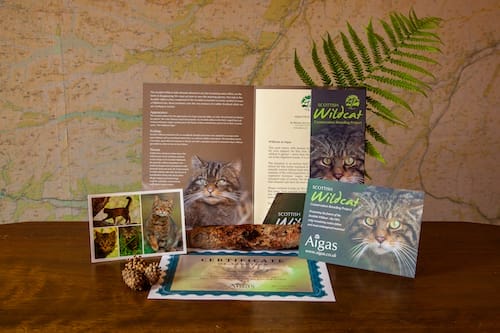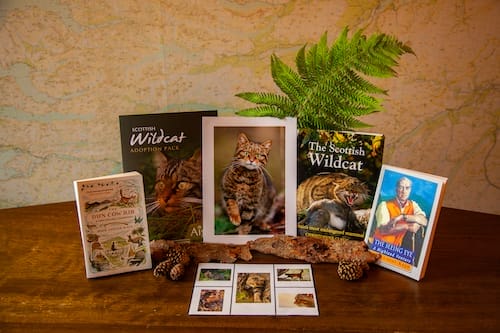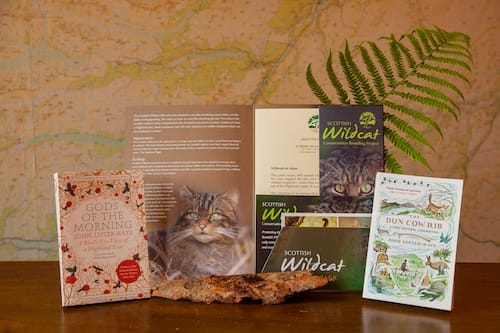The Role of Aigas
At Aigas Field Centre we are committed to conserving wildcats in Scotland. From our inception in 1976 we have been spreading awareness of the threats facing these creatures whilst championing their protection in the wild.
‘The Aigas Wildcat Conservation Breeding Programme’ was set up in 2011 and we are now breeding these animals in collaboration with over 40 other organisations, who share the ultimate goal of releasing wildcats back into large tracts of healthy Highland habitat. This group of organisations act together under the banner of ‘Saving Wildcats’.
Recently being declared functionally extinct in the wild, the captive breeding of wildcats has secured their future in Scotland. The first year of cats being released back into the wild was 2023, with 19 young cats released into the Cairngorms from a state of the art breeding-for-release centre.
The Wildcat in Scotland
The wildcat Felis silvestris silvestris is our last remaining native feline, although without our intervention it would permanently disappear from the wild. Saving this stunning species from extinction in the UK is of utmost importance. Not only is the wildcat a key component of the Scottish ecosystem and iconic symbol of many a Highland clan, these creatures carry the very essence of a wilder Scotland which we are working to restore.
Appearance
The wildcat has the appearance of a large muscular tabby cat with a broad head and distinct fur pattern. The most obvious visual characteristic of a wildcat is the thick, ringed tail, with a blunt, black tip.

Ecology
Wildcats evolved to live in woodlands, though some have now adapted to occupy more open habitats such as moorland and farmland. As an ambush predator, waiting outside the burrow of rabbit or small rodent is an ideal feeding strategy for the wildcat. Though if presented with the opportunity they will predate birds and reptiles.
Wildcats generally live solitary lives except for during the mating season and when kittens are young. The breeding season is in late winter, generally from January to March and after a gestation period of around 64 days, wildcats give birth to a small litter of usually one to four kittens. At this time of year, male wildcats will expand their range in search of receptive females. After mating male wildcats play no role in raising any kittens, this responsibility lies with the mother. The young cats will disperse at around 8 months old.
History
Wildcats started to recolonise Britain alongside many terrestrial mammals at the end of the last ice age (~11,000 ya) whilst a land bridge between Britain and mainland Europe existed. During the last few thousand years, wildcats carved out a niche for themselves as a medium sized predator, preying mainly upon small mammals. Living alongside bears, wolves and lynx was part of everyday life for the wildcat, though being a great climber with abundant woodland present provided the wildcat many places to hide if necessary. When humans started significantly altering the UKs ecosystems, the wildcat’s fortunes began to change due to habitat fragmentation and hunting.
Threats
Habitat loss and persecution drove the wildcat from much of Britain and into its last refuge in the Scottish Highlands. Because the wildcat population was small and fragmented, hybridisation with domestic feral cats took off. Unfortunately, wildcats still suffer the threats of persecution (illegal trapping and poisoning), roadkill, unhealthy environments and habitat fragmentation.
Aigas Wildcat Adoption Scheme
The Aigas Wildcat Conservation Breeding Programme is funded by the Aigas Trust a registered charity and relies on donations to operate. By adopting an Aigas wildcat you will be contributing towards food, enclosure maintenance and building, husbandry costs and veterinary fees. Your donation will go to the Aigas Trust. Conservation breeding has been a vital tool in preventing wildcats in Scotland from going completely extinct, we must continue to breed wildcats in captivity to help rebuild a strong wild population.
Adoption Options
If you would like to make a contribution to the Aigas Wildcat Conservation Breeding Programme by adopting we have a variety of adoption packs for adults, detailed below.
If you you have any questions, please contact the Aigas office at info@aigas.co.uk. We are happy to answer any questions you have.
- Receive an Adoption pack, which includes a personalised thank you letter, certificate, information about the Aigas breeding programme, a wildcat postcard, a subscription to our donors e-newsletter (4 newsletters a year: Spring, Summer, Autumn & Winter), biographies of all the wildcats currently in the Aigas breeding programme.

£10 per month or £120 Annually
- Adoption pack
- A signed copy of The Scottish Wildcat, by Christopher Clegg


£20 per month or £240 Annually
- Adoption pack
- A signed book by Sir John Lister-Kaye of your choice OR signed Christopher Clegg Book on Wildcats
- A photographic wildcat print by Laurie Campbell – there are multiple prints to choose from. You will be shared catalogue of prints once you have made your donation. If you would like to see the catalogue before please email and ask.

Further Information
For information on what work has been taking place in the field around the Scottish Highlands please follow this link to Scottish Wildcat Action (SWA).
For information on the next six years of wildcat conservation in Scotland please follow this link to information about the Saving Wildcats Project.
Report Wildcat Sightings
If you have seen what you think is a wildcat you can report the sighting to SWA here.
Or if your sighting has taken place locally to Aigas or the surrounding straths and glens, please also report this to Aigas Field Centre.
For more information on the work The Aigas Trust does, please visit: www.theaigastrust.co.uk






